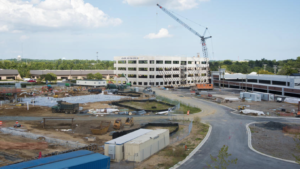Office Construction Warms Slowly as Labor Market Heats
Baltimore Sun | Natalie Sherman

Baltimore (August 20, 2016) – Since the recession, Baltimore-area firms that build offices have been holding back on construction, working to fill empty spaces left by the economic crash.
But as job growth accelerates, there are signs that is starting to change, at least in parts of the region.
Almost 2 million square feet is in some stage of development, the largest amount of new supply in the pipeline since 2007, according to some counts from firms tracking the market.
The projects include new corporate headquarters for large companies such as spice maker McCormick & Co. and JMT, an engineering and architectural firm, but also buildings underway even without a tenant.
“I meet with some disbelief when I talk with people about this,” said Patrick Latimer, research manager at the commercial real estate firm JLL. “It may feel like not a lot’s happening because these are leases where sites are selected pretty far in the past, but everything that’s happening right now is an historic, 10-year high point.”
St. John Properties, the Baltimore County development firm behind many of the region’s suburban office parks, has about 650,000 square feet of new office and flex space, which can accommodate both office and industrial use, underway in the region. St. John’s 10 buildings range from a five-story, 126,500-square-foot office building near Interstate 97 in Anne Arundel County to a small flex property in Carroll County.
The company expects to complete all of them by the end of next summer, said Richard Williamson, the firm’s senior vice president of leasing. About four leases are in the works, with interest in the remaining space, he said.
“We’ve seen stable demand for our products, both from existing clients and from new prospects as well,” he said. “We’re a little more bullish, where in the past we were waiting for those winds to change a little bit.”
St. John benefits from having a big portfolio, with large development sites, including Maple Lawn south of Columbia, which can draw employers from the Washington region. Flex buildings, which represent about 40 percent of the new projects, also tend to be less expensive to construct. And with the economy picking up, the company wants to get ahead of the pack, Williamson said.
“We want to have space available when companies need it,” he said.
In Baltimore, near the stadiums, Caves Valley Partners expects to finish a new 72,000-square-foot, six-story office building by next spring, said partner Arthur Adler. The firm is working with tenants but has no signed leases after parting ways with United Way of Central Maryland.
Adler said the company knew that deal was not coming together when it started construction but decided to move forward anyway, based on the strong leasing demand at its nearby properties as well as at McHenry Row in Locust Point.
“Like in many markets, some areas are hot as can be and some areas are less,” he said. “There are certainly other markets in the Baltimore metropolitan area where there is an oversupply. We hope that we focus on areas where we believe there’s not an oversupply and leasing can be at the right pace.”
Building without a tenant committed remains rare, even though job growth in the Baltimore region has increased steadily since 2013.
The metro area, which includes Baltimore, Towson and Columbia, added more than 30,000 jobs over the 12 months that ended in July, according to estimates from the U.S. Labor Department, which were not seasonally adjusted. Many of those were in the office-using professional and business service sector.
Despite the growth, the vacancy rate across the region has remained in double digits, hovering around 13 percent at the end of June, according to research reports from brokerage firms.
As employers shift toward layouts that accommodate more workers, it is not translating into new office development in the way it once did, especially in high-growth industries such as tech.
“Those kinds of trends mean that even when you’ve got job growth, you’re not seeing a linear (expansion) in office space demand,” said Revathi Greenwood, director of research and analysis for the Washington and Baltimore area at the brokerage CBRE.
When a new project is announced, much of the space is already taken, analysts said.
The 37,500-square-foot Lion Brothers Building in Southwest Baltimore, which celebrated its groundbreaking last week, had already leased two-thirds of the space by last month when construction began a ” in part due to the insistence of lenders, said John Renner of Cross Street Partners.
“We had to spend a good bit of time, a year really, leasing the project before we could close on our financing,” he said.
In general, new construction is expensive, and there’s still space available at a lower cost for tenants who need less room, said Matt Myers, who works on strategic advisory services for the brokerage Cushman & Wakefield. He said many firms, especially downtown, are taking a wait-and-see approach, extending leases with landlords from the recession days and waiting to see whether more options emerge.
For tenants looking for large amounts of high-end space, the market is already tight.
The tenant advisory firm CRESA recently issued a report saying there is not enough Class A office space in the region, despite the vacancy rate, to satisfy demand in coming years, but developers might start to respond, said Will Wheaton, a senior research manager with CRESA Baltimore.
“If you were going to build a big new building, you’d want to see sustained improvement to the market,” he said. “The market’s been doing well in the last two or three years. But from the developers’ standpoint, it’s still new in the process, so I think they’re probably just coming around to the idea.”
http://www.baltimoresun.com/business/bs-bz-office-market-update-20160819-story.html


